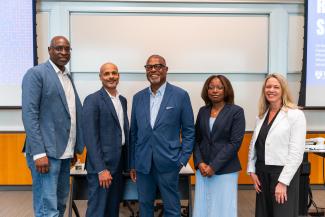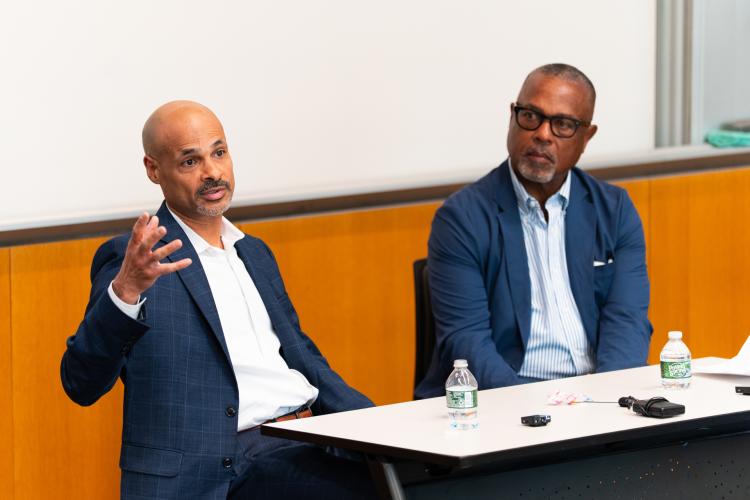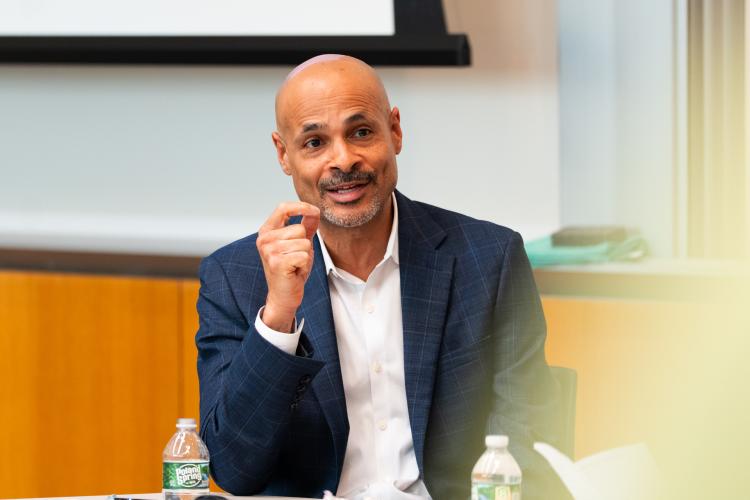
Last year, there were nine non-white head coaches in the National Football League (NFL), six of whom were African American. N. Jeremi Duru, author of Advancing the Ball: Race, Reformation, and the Quest for Equal Coaching Opportunity in the NFL and professor of law at American University’s Washington College of Law, pointed out that this number is a far cry from the days when Fritz Pollard became the NFL’s first—and only—Black head coach in 1921, a milestone not repeated until Art Shell was hired by the Oakland Raiders in 1989.

Duru was in conversation with Wharton Professor Emeritus Kenneth Shropshire, the architect of the Race & Sports seminar. Together, they examined the Rooney Rule and its evolving role in the NFL and beyond. Duru explained that the rule has been a “net positive,” though not without its ups and downs. He reminded the audience that Black players were essentially barred from the NFL from 1934 to 1946, and when they were readmitted, an unwritten rule excluded them from key leadership positions—Quarterback, Linebacker, and Center—positions believed to require high levels of intelligence and decision-making. Black players were valued for their physicality, not their intellect—an assumption that extended into coaching, where they were rarely considered for head coaching jobs.
In a particularly illuminating moment, Professor Shropshire asked Duru about the contributions of attorney Johnnie Cochran and Cyrus Mehri, and their connection to Penn. Cochran and Mehri commissioned a groundbreaking study on racial disparities among NFL coaches, which was researched and written by Penn professor Janice Madden. Her report revealed stark inequities in hiring, firing, and performance evaluations of Black head coaches. Duru recalled how Cochran’s off-script declaration at a press conference— “If they don’t negotiate, we will litigate”—catalyzed the creation of the Rooney Rule.

The conversation then turned to the rule’s immediate impact, including the hiring of Marvin Lewis. Despite being widely regarded as one of the best defensive minds in football, Lewis had repeatedly been passed over for head coaching jobs. After the Rooney Rule was enacted, Lewis was hired by the Cincinnati Bengals, becoming their all-time winningest coach and earning Coach of the Year honors in 2009.
Following that success, Cochran and Mehri helped establish the Fritz Pollard Alliance to advocate for diversity in coaching, front-office, and scouting positions across the NFL. The Alliance pushed for fair hiring practices, full enforcement of the Rooney Rule, and accountability in team decisions. One of the first Black NFL executives, John Wooten, became chairman of the Alliance and led it for over a decade. Duru shared how Wooten would often counsel Black coaches who were worried about being used for “sham interviews.” Wooten’s advice: “Go and get the experience.” For many in the audience, stories like these pulled back the curtain on professional sports, revealing just how much the Rooney Rule’s legacy extends beyond the field.
Many attendees were surprised to learn how deep the history went—not only about the rule itself but also about figures like Johnnie Cochran, who is most widely known for his role on O.J. Simpson’s legal team.

Continuing in that spirit of historical context, Professor Shropshire asked Duru to explain the legal backdrop of the time—particularly the role of the courts in assessing Affirmative Action. Duru walked the audience—many of whom had not been born when these debates raged—through the landmark Grutter v. Bollinger and Gratz v. Bollinger Supreme Court decisions. Both raised constitutional questions about whether race-conscious admissions policies violated the Equal Protection Clause of the 14th Amendment. Duru emphasized that Cochran, Mehri, and Madden were acutely aware that any hiring policy explicitly based on race would likely face legal challenges. Given the increasingly hostile political climate toward Affirmative Action, the Rooney Rule was crafted with a process-oriented approach—focusing on opportunity rather than outcome.
As Duru explained, that legal strategy made the rule exportable. High-profile corporations and other industries have since adopted similar models. But Duru also sounded a note of caution: in the current climate, particularly with growing resistance to DEI initiatives, “there’s been a norm of capitulation among universities and law firms.” He stressed that “it’s critical there not be preemptive and unnecessary compliance,” and that the Rooney Rule provides an example of how to preserve equity-focused practices within legal bounds.
Ultimately, the discussion between Professors Shropshire and Duru offered more than commentary—it was a deep dive into one of the more effective frameworks for increasing minority opportunities in professional sports. Both men are among the nation’s leading experts in the field, and the audience walked away with a renewed appreciation for the significance of the Rooney Rule, and for Shropshire’s opening observation: Jeremi Duru is the leading scholar on Race & Sports in America.
